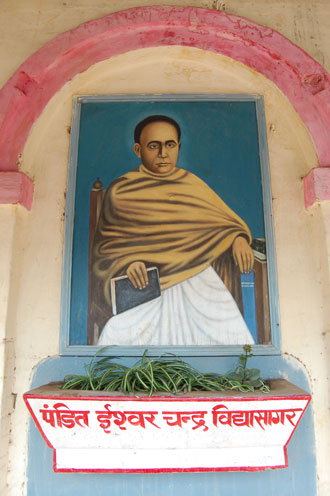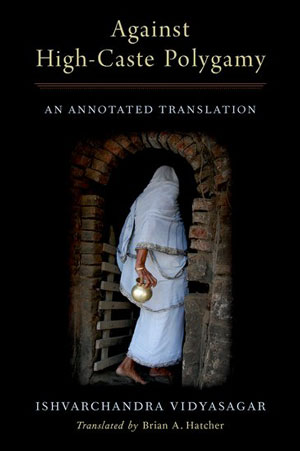
Ishvarchandra Vidyasagar was a mid-nineteenth century Bengali social reformer renowned for putting his Sanskrit learning and sense of compassion in the service of progressive change. He is revered as a champion of Hindu women’s causes, not least the right of Hindu widows to marry (see Hindu Widow Marriage, 2012). Having played a role in passage of the Hindu Widow’s Remarriage Act of 1856 (Act XV), he continued to pursue change in the customs and laws shaping women’s experience of marriage and widowhood. He took his next major step in this direction in 1871 when he published a small book arguing for the abolition of what is known as Kulin polygamy, or Kulinism. Against High-Caste Polygamy is my annotated translation of that book.
In brief, Kulinism refers to a distinctive system of marriage practices chiefly within Brahmin and Kayastha caste communities in Bengal. The ostensible goal of this system is to ensure the preservation of revered clan status (known in Bengali as kula). This is accomplished through the restricted gifting of young brides to grooms possessing high clan status. In Vidyasagar’s day the system had run off the rails. Families seeking upward social mobility were willing to purchase Kulin grooms, often to their financial peril. Kulin grooms, knowing the value of their clan status, would willingly accept more than one wife as a way to accrue more wealth; it was not uncommon for men to have five, ten, or twenty wives. Most of these women rarely saw their husbands and remained a burden on their own relations. If that burden proved too heavy, the Kulin wife might be abandoned or trafficked into sex work. And—as inevitably happened—when these young wives lost their elderly husbands, they were condemned to live out their lives as widows. Emblems of ill fortune, they were routinely abused and neglected. Some were sent to live in widow’s homes in far-off places, while the most desperate took their own lives.
In the end, Vidyasagar’s appeal to abolish Kulin polygamy issued into no new legislative enactments. There is an irony here, since successful passage of the Hindu Widow’s Remarriage Act of 1856 actually produced little positive social change, while Vidyasagar’s failed campaign against polygamy actually presaged a time not far off when Kulin marriage customs would begin to fall from favor. As translator and commentator, my goal has been to situate Against High-Caste Polygamy in its historical moment, while helping readers appreciate Vidyasagar’s facility in moving between description of the lived worlds of Kulin women and the technical registers of Hindu and colonial law. In the process, I hope to have captured the shifting nuances of Vidyasagar’s language, from cool-headed analysis, to empathy, to irony, scorn, and anger.
The question of Kulin polygamy had been highlighted by reformers prior to Vidyasagar, and attitudes remained mixed in his own day. Far from being alone in rejecting the custom, Vidyasagar faced the challenge of convincing those readers who shared his moral revulsion but who nonetheless believed it was unnecessary, if not inappropriate, to seek government intervention. These were not blind followers of orthodoxy, but people who were confident that Kulinism would wither away with the advance of modern education. Vidyasagar’s impatience with such claims is palpable, but it is clear how much he was actually fighting against the temper of the times.
In a sense, by 1871 Vidyasagar faced the challenge of winning over two reluctant constituencies, the British and the Bengalis. Little more than a decade had passed since the suppression of the Indian rebellion of 1857. In its wake the British remained anxious about the stability of their rule; there were some in the government who believed the uprising had been precipitated by legal interventions like Act XV. The British had little desire to intervene further in Indian religious and social life. Vidyasagar knew this and gave vent to his frustration. At one point he even looks back wistfully to an earlier era when the British had professed some commitment to improving India. Now, he tells his readers, “those days are gone.”
At the same time, Bengalis themselves, and Indians more generally, had also begun to chafe at the idea of petitioning the colonial government for help with their own affairs. In this respect Vidyasagar appears to have been out of step with the political trends of his day. When he hears people say Bengalis should be left to take care of their own affairs, he tells his audience he has to smile. But that smile communicates a kind of disdain for his contemporaries. Echoing colonialist tropes of Indian weakness, he accuses Bengalis of lacking the intelligence and character to rectify their own errors. He especially blames a “new community” of educated Indians for lacking the conviction to embrace change. These are harsh words from someone who, alongside social reform, had dedicated his life to the advance of education in Bengal. For all his righteous bemusement, Vidyasagar ends up looking like the vestige of a bygone era. At the very moment when nationalist sentiment was beginning to express itself, when Indians had begun to chart new paths towards effecting change on their own terms, he seems stubborn, dismissive, even perhaps obtuse.
Vidyasagar’s critique of Kulinism is both like and unlike his work advocating widow marriage. As I have argued elsewhere, what makes Hindu Widow Marriage distinctive is its attempt to adapt the exegetical tools of medieval Hindu law to the task of proposing modern legislation. It is a work centered on scriptural citation and legal hermeneutics. Against High-Caste Polygamy departs from this pattern, by engaging a range of other rhetorical, interpretive, and explanatory methods. One does find the necessary overview of Hindu legal texts, but readers will discover much more.
An accomplished story-teller, with a lifetime’s familiarity with rural Bengali life, Vidyasagar brings the stark realities of Kulinism into view through imaginative vignettes and compelling illustrations drawn from his own research and experience. He documents the stunning mendacity of Kulin grooms and their families; he reveals the casuistry of Kulin apologists; and, above all, he evokes the pain and suffering of ordinary Kulin wives and widows. As he says at one point, “Other wives live in the same house as their husbands; they receive food and clothing from their husbands; and throughout the year they enjoy the pleasures of living with their husbands. For Kulin daughters, the mere idea of living in their husband’s house, enjoying life with him, and being cared for in this way is nothing but a dream.” As for the men who profited from such marriages, Vidyasagar’s scorn is palpable. He reports how they maintained account books to keep track of their many marriages, and openly boasted of visiting their wives only when they were promised financial rewards.
Alongside such vivid descriptions, Vidyasagar deploys a number of critical tools that were just beginning to have an impact on the study of social life in India, not least positivist history-writing, data collection, and what I view as something like a proto-sociological method. As a Sanskrit scholar, Vidyasagar was well positioned to address the kinds of claims made on the basis of Hindu legal tradition, but his openness to new modes of historical analysis meant he was also more than capable of mapping the transformation of Kulinism over time. This makes Against High-Caste Polygamy among the nineteenth century’s first attempts to use historical-critical tools to question a particular social custom. As he is able to show, Kulinism may have boasted roots extending centuries into Bengal’s past, but by his own day it had devolved into little more than a business. And within the economy of Kulinism, the women were always the losers.

While it is true that Vidyasagar’s opposition to Kulin polygamy would eventually become common sense, it is worth noting that it was not until 1955 that polygamy among Hindus was finally outlawed in the Hindu Code Bill. This is just one reminder that a text like Against High-Caste Polygamy must be situated within a long history of modern Indian engagements with the reformation of religious and social life—especially in regard to the lives of women. And that long history, while it has featured some significant victories such as Act XV, has also been punctuated by defeats and betrayals. I have already mentioned how Act XV ended up becoming something of a dead letter in terms of promoting change. Truth to tell, the act had more than one deleterious side-effect. First, by making publicly visible the caste-privileged ideal of restricting women’s marital lives, Act XV actually spurred many caste groups to embrace the ban on widow marriage as a tool for gaining new social prestige. Second, there was a significant liability built into the act: a widow who chose to remarry renounced any claim she had to her deceased husband’s inheritance. In a context where women’s autonomy was already constrained, this represented an enormous disincentive.
The ineluctable connection between marriage and property is just as evident when reading Against High-Caste Polygamy. After all, one of Vidyasagar’s achievements was to spotlight the way women served as little more than exchange commodities in an economy of marriage. Within that economy they remained powerless—when they were not expendable. Just as tragically, the very forces of nationalist assertion that opposed foreign interference in Hindu cultural practices, contrived in other ways to disenfranchise the Hindu wife and widow. Those who resisted Vidyasagar’s appeal for government intervention did so on the strength of culturalist pronouncements that celebrated the sanctity of the Hindu home. Not surprisingly, the burden for ensuring that sanctity fell on the Hindu wife—she who must remain faithful through life and death, always self-denying and chaste. Deified but denatured, the very wives and widows for whom Vidyasagar had fought, found themselves further disempowered.
One might argue that little has changed down to the present day, when Indian women continue to fight for autonomy as well as for social and economic justice. The forces ranged against them remain tragically familiar, not least male control over property and the right of male religious leaders to speak for women’s goals and values. Even today polygamy remains a matter of intense debate, not least as a Hindu majoritarian government operationalizes stigmas around Muslim polygamy to bolster its own political fortunes. Women from all of India’s religious communities continue to seek fairness and justice. The times have sadly not changed all that much.


Brian A. Hatcher is Packard Professor of Theology in the Department of Religion at Tufts University. He is a scholar of religion in modern South Asia, with a special interest in colonial Bengal. He is the author of several monographs, including Idioms of Improvement: Vidyasagar and Cultural Encounter in Bengal (1996) and Bourgeois Hinduism, or the Faith of the Modern Vedantists (2008), and Hinduism Before Reform (2020). He has previously translated Ishvarchandra Vidyasagar’s Hindu Widow Marriage (2012).